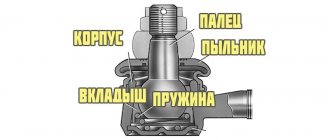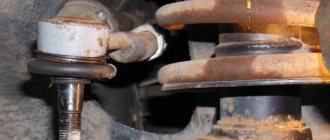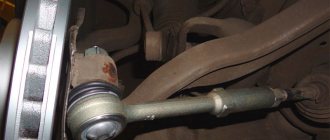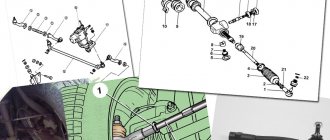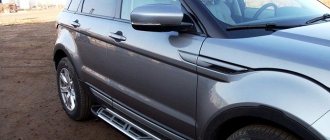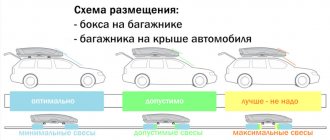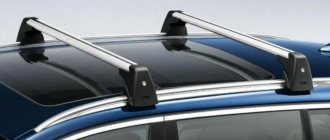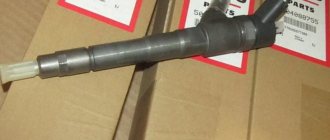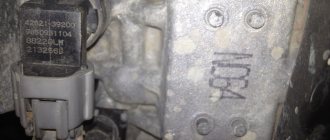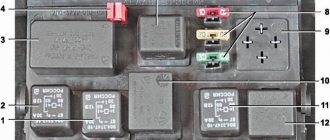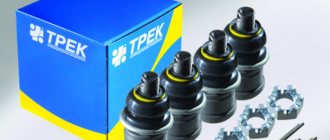A steering link in a car is needed to transmit forces from the steering wheel to the steering arms, due to which the wheels turn. This is facilitated by hinges installed at the end of the rod. It provides the desired angle of rotation of each wheel.
A common failure of the steering linkage is the failure of the joints. This is mainly due to wear of the rubber liner. But, even if only this element has become unusable, driving the vehicle becomes difficult. The cause of hinge failure is prolonged use.
A less frequent breakdown is a malfunction of the boot. This happens due to the ingress of dirt and dust particles.
Breakdowns of the rods themselves occur much less frequently, only due to mechanical damage (impact or driving into a hole).
What is the steering like?
Vehicles can be equipped with any of the control system designs, such as rack or worm gear. The latest design is characterized by resistance to impacts when driving on bumpy roads, a significant steering angle, and increased force transmission. However, there is also a drawback, which is the low information content of the steering wheel and difficult driving.
The described phenomena arise due to the large number of ball joints and steering rods, due to the occurrence of play in them. Since the design of this type of vehicle control has more disadvantages than advantages, for this reason the worm mechanism is practically not installed on modern automobile models.
Another thing is the rack and pinion mechanism, which has an acceptable cost, a minimum number of moving elements, as a result of which it is distinguished by its compactness and reliability. However, this type of control also has its drawback, which is the impossibility of installing it on heavy vehicles due to the increased resistance to shocks while driving on uneven roads, which are very well transmitted to the steering wheel. If in this case it is not difficult to handle a passenger car, then holding a heavy vehicle will be quite problematic. In addition, you often have to deal with another unpleasant phenomenon - imbalance of the steering rack.
Diagnostic methods
It is easier to identify faulty parts by lifting the car on a lift or driving it onto a ramp in order to have a complete picture of the condition of the elements located under the bottom. It is in this area that the main components of the control system are located. After this, the condition of the tip hinge should be assessed. This can be done by pressing on it. If the element is loose, this indicates wear and tear and the need to replace it. Thus, it is necessary to check all the traction by moving the steering wheel to different positions.
We evaluate the condition of the protective rubber boots. There should be no damage, cracks or scratches on them, otherwise dirt, water and chemicals, which are abundantly sprinkled on roads in winter, will penetrate into the hinge joint, accelerating its wear.
The rod itself should not have any mechanical damage or deformation that negatively affects its integrity. As you can see, the steering linkage is not complicated in design and has a good margin of safety. The main thing is to always monitor the condition of this element.
The role of steering rods in the car control system
In addition to changing the trajectory of movement, the steering drive helps prevent lateral sliding of the steered wheelset. To do this, the wheels must have different rotation angles: the outer wheel has a smaller angle, and the inner wheel has a larger angle. This is possible thanks to the presence of a steering linkage, the design of which includes the following rods:
- Left.
- Right.
- Average.
Depending on their location, they are further divided into longitudinal and transverse.
Technological sequence of operations
Traction is selected according to the car manufacturer's article number. For foreign cars, the dimensions and shape of the rod often change within one generation of the model. When replacing a deformed part, auto mechanics from the S-MOTORS service:
- raise the car on a hydraulic lift;
- dismantle one or both wheels;
- disassemble the trapezoid (remove clamps, boots, tips);
- unscrew the steering rod from the rack housing;
- install a new part;
- fill the anthers and hinges with grease, and install the cotter pins correctly.
If you notice signs of a car control malfunction, call us, send a request to the S-MOTORS car service website. Our auto mechanics are well aware of the design features of foreign and Russian cars and quickly find the causes of breakdowns. Replacement operations are carried out technologically correctly, according to the positions of the car manufacturer's technological map. When installing the rod in its normal place, an adjustment is made and the car is tested in motion.
Caliper repair
Brake caliper repair
Replacing brake discs
Replacing brake discs
Replacing brake fluid
Replacing brake fluid
Marina
The pads are my headache. I constantly have problems with them. This time I installed the original ones, they were made in Lyublino at S-Motors. So far, ugh, ugh, everything is fine, I’ll keep my fingers crossed)
Gleb
The friction linings were worn out and an unpleasant squeak began to appear. I stopped by on the way home to the service center. The guys fiddled around and found the reason. Everything has been fixed, I’m riding)
Nikolai
I changed the rear brake drums at S-Motors and ordered them. I live nearby, so it was more convenient to leave the car overnight. I picked it up in the morning. Thanks guys, we were probably fiddling around late at night.
5% discount with customer card, call to make an appointment
SIGN UP
Purpose of longitudinal steering rods
In a vehicle control system, this type of rods is assembled using a hinge with a swing arm. Rotating, the steering bipod moves the middle link of the trapezoid to the right or left, changing the angle of rotation of the wheels through the side links. In the event of failure, the longitudinal steering rod must be replaced, but this procedure is particularly difficult because, due to its location, it is difficult to get close to it in order to unscrew it.
Symptoms of malfunctions
If you do not pay attention to the wear of the tie rod ends, the ball pin will become loose and jump out of its socket at the first decent bump. There is no need to explain for a long time what this entails: the wheel will become uncontrollable, and the driver will lose control of the car. How to determine that there are problems with the hinges and the car’s chassis needs to be checked:
- the first sign is a dull, frequent knocking sound when driving over small bumps, especially in turns;
- as a rule, extraneous sounds are heard from one side, but simultaneous wear of two tips also occurs;
- the free play of the steering wheel increases;
- when negotiating a turn on an uneven road, you can feel a tapping sound on the steering wheel;
- At the last stage of wear of the tips, the car has to be literally “caught” on the road, since due to the play of the ball pins, the wheels can deviate by 2–3° from the straight line.
Note. Unfortunately, such signs are observed not only as a result of problems with the steering rack, but also as a result of wear of the bearing of the rotary bipod and the pendulum. The exact result will be shown by a check performed by car service employees or independently in a garage.
If you find one of the listed symptoms in your own car, you should not delay diagnosis. Especially if the tips have served more than 40 thousand kilometers. To carry out the check, you will need an inspection ditch; hanging the car on a jack will not allow you to swing the rod in the desired direction.
To check the tie rod ends yourself, use the step-by-step instructions:
- Drive the car exactly in the center of the inspection hole so that you can easily reach the hinges. If the ditch is too narrow, the car will have to be moved twice in different directions.
- Support the rear wheels with wheel chocks.
- Grab the rod with your hand as close to the tip as possible. Rock the hinge up and down to feel the play.
- A small elastic resistance indicates that the spring is working and there are no critical gaps. Significant play is felt immediately.
- Rotate the rod several times around its own axis. If it flows easily, literally dangling on the ball pin, the tip should be replaced.
Advice. When swinging the rod, do not confuse the hinge play with free play of the steering rack or a broken pendulum bearing.
To check the integrity of the anthers, an inspection hole is not needed. It is enough to turn the wheel and lift the car with a jack. The hole in the rubber boot is discovered thanks to thick lubricant, which is squeezed out from the inside through a gust.
Replacing the steering tip is also not a big problem; the only special tools you need are a puller to push the ball pin out of the steering knuckle eye. Please note an important nuance: after replacing the linkage, the camber angles of the wheels must be adjusted. You cannot make the adjustment yourself, so you will have to visit a car service center.
Purpose of transverse rods in the control system
Their functional responsibilities are to ensure traffic safety and improve the information content of vehicle control. The inner rod end provides the relationship between the control system and the outer joint. Both joints move freely in all planes, which allows for high precision driving.
In addition, the tie rod has an adjustable threaded connection, thanks to which you can set the optimal position of the front wheelset. Note that increased demands are placed on the articulated ends of these rods, since they are the main elements that ensure the safety of the vehicle while driving.
Signs of damage
The latter can be called consumables. Their service life, on average, is no more than forty thousand kilometers. To increase this indicator, you need to drive only on a flat surface and drive the car very carefully.
So, let's look at the main signs of a breakdown that can cause a car to malfunction.
- Backlash is a clear sign. If, when driving at low speeds, you begin to notice that the wheels of your car are not turning in accordance with the steering wheel, then you need to check the steering mechanism. This should be done urgently; the presence of backlash can lead to the worst consequences.
- Kickback to the steering wheel. If while driving you begin to notice a strong beating of the steering wheel, this is also a sign to check the steering rod and ends.
- The appearance of abnormal sounds. If the boot is damaged, dust appears and settles at the joint.
Thus, when this element operates, sounds appear. In the future, such conditions can lead to premature wear of these parts.
It is very important to respond in a timely manner to the occurrence of abnormal deviations in the operation of your car. Try to spend as much time as possible on the diagnosis. This attitude will allow you to keep your car and its components for a long time.
Some features
The steering rack has a simple design mechanism with two rods that are connected to swing arms. The joint end is a consumable part, the wear of which depends on the intensity of vehicle use and driving style. It cannot be restored, so in the event of a breakdown, only a replacement can save the situation. Note that the scheduled period for replacing tips set by the manufacturer is 35-45 thousand kilometers, but they often wear out earlier.
The steering rod has a long service life, and quite rarely fails solely due to serious mechanical damage due to hitting an obstacle. After replacing a part, it is necessary to restore the wheel alignment settings. The choice of rods depends only on the design features of the car model and the manufacturer’s requirements. Both original and analog parts serve equally well.
Steering rods and ends on a Chevrolet Lacetti: replacement - AutoExpert
- Purpose of steering tips
- Original Chevrolet Lacetti steering ends or equivalents
- Signs of malfunctioning Chevrolet Lacetti steering tips
- Resource and frequency of replacement of steering tips
- Rules for replacing steering tips for Chevrolet Lacetti
What does this have to do with the ball joint?
There is a possibility that the gap will not be detected, although the play will be obvious. And here you should suspect problems with the ball joint. You can check whether it is really faulty in the same way as in the case of diagnosing the steering tip. It is necessary to rock the wheel by placing one hand on the ball joint. If there is a gap, it will be impossible not to notice it.
If you discover malfunctions during the diagnostics described, do not delay in replacing damaged parts. This can lead to their permanent breakdown during the trip and a serious accident. After the repair, do not forget to go to a service center to have the wheel toe angles adjusted. It is necessary!
- How to remove a wheel if the edges of a bolt or nut are torn off, see (and read) here.
Other episodes of “Technical Environment” are available in our special project, as well as on our YouTube channel.
